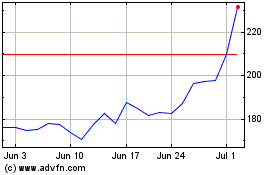Tesla Begins Equipping All Vehicles With Self-Driving Hardware
October 19 2016 - 10:00PM
Dow Jones News
Tesla Motors Inc. has begun equipping all of its vehicles with
hardware to make the vehicles fully self-driving and Chief
Executive Officer Elon Musk expects to demonstrate a self-driven
cross-country trip by the end of next year.
"As of today, all Tesla vehicles produced in our
factory—including Model 3—will have the hardware needed for full
self-driving capability at a safety level substantially greater
than that of a human driver," the company said in a statement,
referring to its coming midprice sedan. The high-end Model S and
Model X with the hardware are already in production, while the
Model 3 is slated for delivery late next year.
The software that would make Tesla vehicles fully self-driving
still needs to be validated, and the system hasn't been approved by
regulators.
The new hardware will initially lack the same capabilities as
Autopilot, the company's current semiautonomous feature, as the
company works to calibrate the new system. That should take two or
three months, Mr. Musk told reporters on Wednesday. After that, he
said, the company plans to improve its autonomous capabilities
every two or three months.
Mr. Musk's goal is to demonstrate travel in fully autonomous
mode from Los Angeles to New York City by the end of next year, he
said.
Tesla's effort to introduce the next generation of autonomous
driving capability comes as the auto maker faces increasing
scrutiny over the semiautonomous Autopilot system already installed
in its vehicles. The current version, which is enabled in Tesla
vehicles built after October 2014, uses cameras, sensors and radar
to control vehicle speed and steering under certain driving
conditions. While not a fully self-driving system, it is regarded
as a major step toward that end.
However, regulators worry that the technology lulls drivers into
complacency behind the wheel. Germany's Transportation Ministry has
asked Tesla not to use the term Autopilot in ads describing the
system, and the California Department of Motor Vehicles has issued
draft rules that would prohibit the use of "autopilot" in marketing
materials for systems similar to Tesla's current capabilities.
U.S. regulators are investigating a fatal crash that occurred in
May in Florida, which Tesla has said was the first known fatality
involving Autopilot. An update to Autopilot's software last month
may have prevented that crash, Mr. Musk has said. The changes
included making the system more reliant on radar to navigate.
Since the May crash, Tesla and auto-parts supplier Mobileye NV,
a leading company in providing semiautonomous driving technology,
have disagreed publicly about whether Autopilot is being used
appropriately. The supplier took the unusual step of saying it had
warned Mr. Musk more than a year ago about its safety concerns in
allowing Autopilot to be used for hands-free control of vehicles.
Tesla chalked up the disagreement to Mobileye being threatened by
its own in-house development of a computer-vision system.
The new system has eight cameras, compared with one in previous
Tesla vehicles, providing 360 degrees of visibility up to 250
meters in range, while the onboard computer has more than 40 times
the computing power of the previous generation, according to
Tesla.
Write to Tim Higgins at tim.higgins@wsj.com
(END) Dow Jones Newswires
October 19, 2016 21:45 ET (01:45 GMT)
Copyright (c) 2016 Dow Jones & Company, Inc.
Tesla (NASDAQ:TSLA)
Historical Stock Chart
From Aug 2024 to Sep 2024

Tesla (NASDAQ:TSLA)
Historical Stock Chart
From Sep 2023 to Sep 2024
